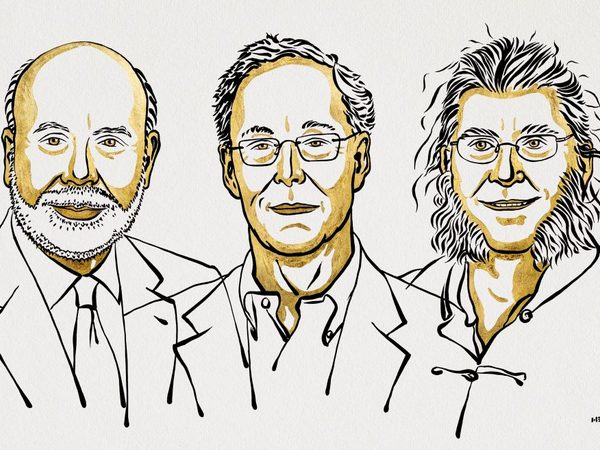The Nobel Prize in Economic Sciences 2022 was awarded to Ben Bernanke (Brookings Institution di Washington), Douglas Diamond (Chicago University), and Philip Dybvig (Washington University in St. Louis), “for research on banks and financial crises”.
Banks facilitate the relationship between people who have funds to invest and those who require financing, playing a key role in their allocation. The relationship between borrowers and lenders that is mediated by banks is widespread in our economies as it allows for the funding of many types of projects: firms can obtain loans to build new plants; families can obtain a mortgage to buy a house; start-up companies can begin to market and sell new services; and so on.
Over the last few years, other intermediaries have emerged to channel the funds accumulated by savers. However, banks have maintained a crucial role because of some essential functions they perform.
The first is transforming short-term deposits into long-term loans. Many of the funds managed by banks come from savers as deposits that can be withdrawn at short notice to be used for unforeseen expenses. Without the intermediation of banks, savers would not be willing to block their savings to finance long-term projects. Banks allow clients to transform the maturity between lenders and borrowers.
The second function performed by banks is to monitor borrowers. Projects are risky because their outcome depends on uncertain future events and because borrowers may try to avoid repaying their debt. This is why borrowers must be monitored. It would be too challenging for each lender to monitor the projects he or she has invested in. This necessity can be delegated to banks, who can conduct monitoring at a lower cost.
The third function performed by banks is providing indirect access to diversification. By aggregating savings, banks can diversify their investments and avoid project-specific risks, and therefore gain returns that are less variable than those on single projects.
Although all of these functions have long been known to economists and financial operators, the work by Douglas Diamond and Philip Dybvig at the beginning of the 1980s is the first which analyses them from a sound theoretical perspective, leading to the creation of the theory of financial intermediation which was expanded in later years and is still used today. This theoretical work was accompanied by the empirical analysis of Ben Bernanke (also in the 1908s) on the role that multiple bank failures played in the prolonged crisis of the Great Depression, which started in 1929. The creation of a theoretical framework and the contemporaneous empirical analysis have enabled us to understand how banks should be regulated to safeguard their functions — maturity transformation, debt monitoring, risk diversification — and limit the negative effects that financial crises have on the economy.
In “Bank Runs, Deposit Insurance, and Liquidity” published in the Journal of Political Economy in 1984, Diamond and Dybvig focused on the role that banks play in providing liquidity and allowing the transformation of maturities between lenders and borrowers. They also showed that this particular function regularly exposes banks to the risk of bank runs, so they proposed regulations to avoid this risk. Diamond and Dybvig noticed that bank runs — the uncontrolled massive withdrawal of deposits by savers — might happen not only when people need to spend money due to unforeseen circumstances, but also when everyone withdraws money just because other people are doing so. Not withdrawing one’s deposits when everybody else is withdrawing involves losing that money, because it will be paid out to other people and lead to bank failure. By formalising “bank runs”, the two economists were able to study possible solutions. One of these solutions is government insurance on deposits. When people know that the government is guaranteeing their savings, they no longer need to rush to the bank as soon as they hear of bank runs. This stops bank runs before they start. Therefore, having deposit insurance means it never has to be employed — which is why most countries today insure deposits.
In “Financial intermediation and delegated monitoring” published in the Review of Economic Studies in 1984, Diamond analyses the conditions necessary for banks to conduct debt monitoring. The majority of investments is risky and depends on the actions of borrowers, who might try to avoid paying lenders back, claiming that their investment has failed due to adverse circumstances. In order to avoid this, failure must be costly to borrowers. However, even borrowers who do their job well can sometimes default, and this creates collective costs. In his article, Diamond assumes that banks can monitor borrowers at a certain cost. Thanks to such monitoring, many defaults can be avoided, thereby reducing social costs. If banks did not act as intermediaries, monitoring would be difficult and costly. However, one problem remains: if banks monitor borrowers, who monitors banks? Diamond concludes that the way in which banks are organized means they need not be monitored by depositors. If banks fail to monitor their borrowers, they risk huge losses. And in this case, banks would not be able to pay back depositors, and so they would fail. Therefore, it is in a bank’s best interest to monitor its borrowers. Another aspect highlighted by Diamond is that, even if banks monitor their borrowers properly, they will nevertheless lose some money because their investments are intrinsically risky. However, banks can opt to give loans to a lot of borrowers, so that, even if some fail to pay them back, overall losses will be reduced, thanks to diversification.
The analysis of the role that banks played in the Great Depression in the 1930s was conducted by Bernanke in “Nonmonetary effects of the financial crisis in the propagation of the Great Depression”, which was published on the American Economic Review in 1983 (Bernanke served as the chairman of the Federal Reserve System from 2006 to 2014, so he was able to apply his ideas during the Global Financial Crisis). Between January 1930 and March 1933, industrial production in the US fell by 46% and unemployment rose by 25%. Before Bernanke published the article, the general consensus among economists was that depression could have been prevented if the US Federal Reserve had printed more cash. Bernanke highlighted that this mechanism alone could not explain why the crisis was so serious and long. Instead, he demonstrated that the main cause was the decline in the bank system’s ability to channel savings into funding for firms, due to bank failures as well as to the tendency to invest in low-risk activities that could be easily liquidated.
When a bank fails, the relationship between the bank and its borrowers gets cut off, and establishing a new monitoring system is often too costly. Bernanke showed that the economy was not able to recover until the implementation of measures that prevented other panic attacks and bank runs.
The work of Bernanke, Diamond and Dybvig has contributed to highlighting the role that banks play in the economy, leading to the development of the field of research on financial intermediaries and to the creation of effective regulation measures. The world of financial intermediation is constantly changing. New forms of intermediation, which are often not regulated, are now quite common, and recently there has been the development of other payment systems — such as cryptocurrencies — and of decentralized intermediation thanks to the use of blockchains. The 2007-2009 financial crisis — which involved runs on money market funds rather than on deposits, which by that point were insured — demonstrates that we need to understand new instruments and financial players to identify potential issues and propose regulation. If we fail to do this, adverse circumstances could cause a severe crisis. At the same time, the 2007-2009 crisis shows also that thanks to the research by Bernanke, Diamond, Dybvig and others, the fundamental mechanisms that regulate the way intermediaries function have been partially understood. Thanks to public intervention, the 2007-2009 crisis did not evolve into a depression, unlike the crisis of 1929.
By Pietro Dindo with Stefano Colonnello and Piero Gottardi - Department of Economics, Ca’ Foscari University of Venice











